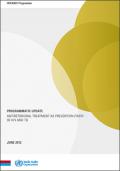Publications - Released in 2012
In 2010, an estimated 34 million people were living with the human immunodeficiency virus (HIV), around 70% of them in sub-Saharan Africa. By the end of 2010, 6.6 million people, or 47% of those in need (CD4+ cell count <350 cells/mm3), were on antiretroviral therapy (ART), and an estimated 7.5 million people were still in need of treatment. While considerable progress has been made in extending ART coverage, there continue to be critical gaps. In the same year, coverage for children was reported to be less than 23%, there were 2.7 million new infections and more than 20 million people were not yet treatment-eligible (as most of them did not know their HIV status). There were an estimated 1.1 million new cases of HIV-associated tuberculosis (TB), which led to 24% of HIV-related deaths. HIV is the strongest risk factor for developing TB, and people living with HIV have a 20–37 times higher risk of developing TB than those who do not. ART has a significant secondary prevention benefit for both HIV and TB, and expanded access to ART has probably averted millions of HIV infections and cases of TB.
The World Health Organization (WHO) has introduced the concept of HIV elimination through the use of combination prevention and prevention of mother-to-child transmission (PMTCT) of HIV. Additionally, WHO and the Joint United Nations Programme on HIV/AIDS (UNAIDS) launched Treatment 2.0 to look at ways to provide better services to a larger number of persons at lesser cost, and in a way that helps to retain them on lifelong ART. This would also greatly benefit HIV prevention efforts.
Downloads
Organizations
- World Health Organization (WHO)






